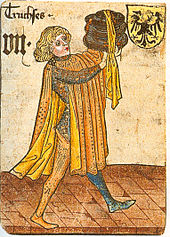Truchsess (court office)
Truchsess was a court office in medieval court society for the highest overseer of the princely table. The expression comes from the Old High German truhtsâzo , 'superior of the baggage ' ( Latin dapifer , French écuyer de cuisine , English steward , Polish stolnik , Dutch drossaard ).
Characteristic
It was originally the name for the chief overseer of the princely table, later for the head of the court. In the course of time the office received other influential functions. Numerous families took the title of office as an integral part of their own family name (see noble families Truchseß and Droste ). The steward or the seneschal corresponds to the office .
In the Holy Roman Empire , since Otto I's coronation, a prince had to set the first bowl on the emperor's table as a stewardess . Like the other ore offices , this later became hereditary and connected to an electorate, the ore clergy office with the Electoral Palatinate . When Frederick V of the Palatinate lost the cure in 1623, the office of the Archbishopric fell to Bavaria and in 1706, following the ostracism of the Elector of Bavaria, again to the Electoral Palatinate, in 1744 again to the Electorate of Bavaria , which held the office until the empire was dissolved in 1806. In courtly ceremonies such as the coronation of the Roman-German kings and emperors , the electors were represented as holders of the ore offices by counts as holders of the respective hereditary offices , for example the archdealer of the imperial inheritance meals , the counts of Waldburg , who also acted as hereditary chefs.
etymology
References go back to the 10th century, for example in Old High German truh (t) sazo or truh (t) sezzo , Middle High German truh (t) säze and Middle Low German droste or drotsete . The term is composed of druhti "crowd" - mainly the entourage of a prince - or chests or drueth "following" and sentences "sitting" (cf. Sasse as in Freisasse , Landsasse and Hinterersasse ) and consequently carries the meaning "Someone who sits in the allegiance" or - possibly even originally - "who heads the allegiance".
Special features in Austria-Hungary
As with the chamberlain ( treasurer in Austria and Bavaria ) , the originally paid and permanent residence at the court of the Habsburgs was transformed into an honorary service for the cupbearers , pre-cutters and truchess . But the number of these court dignitaries was never nearly as great as that of the chamberlains. When, with the advent of the use of the fork, the cutting of meat was no longer done in the dining room but in the kitchen, pre-cutters were no longer appointed at all. The ordering of cupbearers was also refrained from.
The court dinners, for whose attainment acquired domestic nobility was sufficient, however, continued to belong to the "table party" and as such were subordinate to the chief steward , by whom they were also sworn .
If the applicant for the dignity of the truchess belonged to the civil service , he had to at least be an imperial or royal councilor or court (ministerial) secretary . If he was not employed, he would otherwise have to take an honorable social position. Before being sworn in, the appointed chief executive had to identify himself with the payment of the prescribed tax (fee), whereupon he was also given the chief executive officer.
The dinners were court dignities like the chamberlains. They were obliged to follow the court, ranked after the treasurers, were “used to serve the table or at festivals for commissiaria positions ”, had the privilege of “ the court of Corteggiren ” and were particularly active at the “feeding” ceremony on Maundy Thursday . Truchsess was therefore no more than a mere honorary title, just like treasurer, but an employment relationship that required services and was affirmed by oath, which was directly referred to as " honorary office " in the tax patent . On the other hand, the honorary dignity was not a state “award”, but a service and honor conferment belonging to court law.
literature
- Ivan von Žolger: The court of the House of Austria . Franz Deuticke, Vienna 1917, p. 144-145 . (Vienna Political Studies; Vol. 14).
Web links
Individual evidence
- ↑ Medieval Lexicon: Truchsess. Bilder-Conversations-Lexikon, p. 15347 (cf. BC-Lexikon Vol. 4, p. 486)
- ↑ In the 1704 schematic, there are around 450 chamberlains, but only six cupbearers and 18 cupcakes (" so really filed the jury ") and only two pre-cutters. The 1812 schematic shows over 1,000 chamberlains and only 30 truchess.
- ↑ In the Hofschematismen 1812 ff. The heading “Cupbearers and Vorneider” is provided with the note “vacant”. In more recent times this rubric also disappeared.
- ↑ A. u. Lecture of the Obersthofmeister from April 9th, 1773 (original in the house, court and state archives): “ That a derley supplicant did no less than a council or equivalent service, so that this emperor. Court honorary charge was not too mean and contemptible ".
- ↑ Camera tax 157 fl. 50 kr. Ö. W. and expedition tax 31 ducats in gold.
- ↑ See decree of the M. d. I. of March 3, 1869, Mayrhofer-Pace, V, 140.
- ↑ In the announcements of the Wiener Zeitung and the Budapesti Közlöny, the formula is used: “ His kuk Apostolic Majesty has granted the NN the dignity of truchess. deigned to lend. "
- ↑ From January 27, 1840, N. 404, JGS §§134 and 160.
